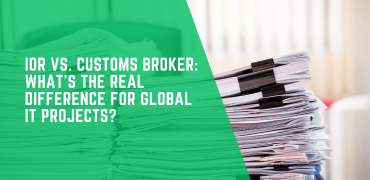In international trade, terms like DDP, DDU, and DAP are crucial for defining the responsibilities and risks associated with the delivery of goods. These terms are part of the Incoterms, a set of rules published by the International Chamber of Commerce (ICC) that clarify the obligations of buyers and sellers in international transactions. Understanding these terms is essential for businesses involved in global trade to ensure smooth operations and avoid misunderstandings. This blog post will delve into the differences between DDP (Delivered Duty Paid), DDU (Delivered Duty Unpaid), and DAP (Delivered at Place), highlighting their unique characteristics and implications for international shipping.
What are Incoterms?
Incoterms, short for International Commercial Terms, are standardized trade terms used in international sales contracts. They provide a common framework to facilitate global trade by clearly defining the responsibilities of buyers and sellers. Incoterms cover various aspects such as transportation, insurance, and customs clearance, helping both parties understand their obligations and avoid disputes. There are 11 Incoterms in the latest version (Incoterms 2020), divided into two categories: rules for any mode of transport and rules for sea and inland waterway transport.
Overview of DDP, DDU, and DAP
Delivered Duty Paid (DDP)
DDP (Delivered Duty Paid) is an Incoterm that places maximum responsibility on the seller. Under DDP, the seller is responsible for delivering the goods to the buyer’s premises or another agreed-upon location, covering all costs and risks associated with transportation, including import duties and taxes. Essentially, the seller handles everything from production to the final delivery, ensuring that the goods are delivered ready for unloading at the destination.
Delivered Duty Unpaid (DDU)
DDU (Delivered Duty Unpaid), although no longer an official Incoterm since its replacement by DAP in 2010, is still widely used in practice. Under DDU, the seller is responsible for delivering the goods to a named place in the destination country, but the buyer is responsible for paying any import duties, taxes, and customs clearance charges. The seller bears all costs and risks until the goods arrive at the agreed destination, but the buyer takes over the responsibility of handling customs formalities and associated costs.
Delivered at Place (DAP)
DAP (Delivered at Place) is an Incoterm introduced to replace DDU. Under DAP, the seller is responsible for delivering the goods to a named place in the buyer’s country, bearing all costs and risks until the goods are ready for unloading. The buyer is responsible for import duties, taxes, and customs clearance. DAP simplifies the process by clearly separating the responsibilities: the seller ensures the goods reach the destination, and the buyer handles the import formalities.
Key Differences Between DDP, DDU, and DAP
Responsibilities and Costs
- DDP: The seller bears all responsibilities and costs, including transportation, insurance, import duties, and taxes. The buyer only needs to unload the goods.
- DDU: The seller covers transportation and insurance costs up to the destination, but the buyer is responsible for import duties, taxes, and customs clearance.
- DAP: The seller covers transportation and insurance costs up to the delivery point, and the buyer handles import duties, taxes, and customs clearance.
Risk Transfer
- DDP: The risk transfers from the seller to the buyer once the goods are delivered to the final destination, ready for unloading.
- DDU: The risk transfers from the seller to the buyer once the goods arrive at the agreed destination.
- DAP: The risk transfers from the seller to the buyer once the goods are delivered to the named place and ready for unloading.
Customs Clearance
- DDP: The seller is responsible for both export and import customs clearance, including all duties and taxes.
- DDU: The seller handles export customs clearance, while the buyer takes care of import customs clearance and related charges.
- DAP: The seller handles export customs clearance, and the buyer is responsible for import customs clearance and associated costs.
Control and Convenience
- DDP: Provides maximum convenience for the buyer, as the seller manages all aspects of the delivery process.
- DDU: Offers a balance of control, with the seller managing transportation and the buyer handling customs formalities.
- DAP: Similar to DDU, DAP allows the seller to manage transportation while the buyer takes charge of customs duties and taxes.
Practical Implications for Businesses
Choosing the Right Incoterm
Choosing the appropriate Incoterm depends on various factors such as the nature of the goods, the destination country’s regulations, and the preferences of the trading parties. Here are some practical considerations for businesses:
- Cost Management: Businesses need to consider the total landed cost, which includes all expenses from production to delivery. DDP might be suitable for sellers who can manage all costs efficiently, while DDU or DAP may be preferred if the buyer has better control over import processes.
- Risk Management: Understanding where the risk transfers is crucial. Sellers might prefer DDU or DAP if they want to limit their exposure to import risks, whereas buyers might prefer DDP to minimize their own risk.
- Logistics Capabilities: The seller’s ability to handle logistics and customs procedures can influence the choice of Incoterm. DDP requires the seller to have robust logistics and compliance capabilities, whereas DDU and DAP distribute these responsibilities.
Example Scenarios
To illustrate the practical application of these Incoterms, let’s consider a few scenarios:
- Scenario 1: A US-based company selling machinery to a German buyer:
- DDP: The US company handles all transportation, insurance, and import duties, delivering the machinery to the buyer’s facility in Germany.
- DDU: The US company delivers the machinery to a specified location in Germany, but the German buyer handles customs clearance and pays import duties.
- DAP: The US company delivers the machinery to a named place in Germany, and the German buyer takes care of import duties and taxes.
- Scenario 2: A Chinese manufacturer exporting electronics to a Brazilian distributor:
- DDP: The Chinese manufacturer manages all aspects of the shipment, including paying Brazilian import duties and delivering the electronics to the distributor’s warehouse.
- DDU: The Chinese manufacturer delivers the electronics to a port or warehouse in Brazil, and the Brazilian distributor handles customs clearance and duties.
- DAP: The Chinese manufacturer delivers the electronics to a specified location in Brazil, and the distributor manages import duties and taxes.
Benefits and Challenges
Benefits
- DDP:
- Maximum convenience for the buyer.
- Predictable total cost for the buyer.
- Simplified logistics for the buyer.
- DDU:
- Flexibility for the buyer to handle customs clearance.
- Potential cost savings for the seller on import duties.
- Clear division of responsibilities.
- DAP:
- Simplified logistics with the seller managing transportation.
- Clear division of responsibilities.
- Flexibility for the buyer to manage import duties and taxes.
Challenges
- DDP:
- High burden on the seller to manage all costs and logistics.
- Potential for increased cost and complexity for the seller.
- Requires thorough understanding of the destination country’s regulations.
- DDU:
- Uncertainty for the buyer regarding final costs due to customs duties.
- Potential for delays if the buyer is not efficient in handling customs clearance.
- Coordination required between seller and buyer for smooth delivery.
- DAP:
- Similar to DDU, with potential for delays if the buyer is not efficient in handling customs clearance.
- Requires clear communication and coordination between seller and buyer.
- Potential for disputes over responsibilities if not clearly defined in the contract.
Conclusion
Understanding the differences between DDP, DDU, and DAP is essential for businesses engaged in international trade. Each Incoterm offers distinct advantages and challenges, influencing the logistics, costs, and risks associated with the delivery of goods. By carefully selecting the appropriate Incoterm based on their specific needs and capabilities, businesses can optimize their international transactions, ensuring smooth operations and minimizing potential disputes.
In summary:
- DDP is ideal for buyers seeking convenience and predictability, as the seller handles all aspects of the delivery, including import duties.
- DDU provides a balance, with the seller managing transportation and the buyer handling customs clearance and duties.
- DAP offers clear division of responsibilities, with the seller delivering the goods to a named place and the buyer managing import duties and taxes.
By understanding and effectively applying these Incoterms, businesses can navigate the complexities of international trade with greater confidence and efficiency.




